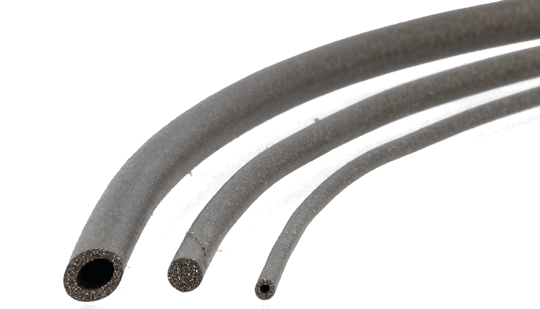- Contact us
- |
- About us
- |
- |
-
- Personal information
- Organization
- Quotes
- Address book
- Login
- Don't have an account? Sign-up
Electrically conductive rubber profiles
- Home
- EMI shielding gaskets solutions
- EMI/IP gasket
- Electrically conductive rubber profiles

Electrically conductive rubber profiles in general are known for their excellent weather-, oxidation and ozone resistance
The rubber in these profiles is made conductive by means of small conductive metal particles, distributed throughout the rubber. It can provide an EMI-proof and a pressure watertight seal in narrow constructions.
Electrically conductive rubbers are typically used for EMI applications. Also used for EMP protection, wave-guide applications and against static electricity. The rubber can be filled with silver, nickel, silvered glass, silvered aluminium or graphite (only for ESD). Commercial EMI applications often call for Nickel-Graphite Conductive Rubber (Part number 5760) or Graphite Conductive Rubber (Part number 5755) due to costs, whereas military and aerospace applications often call for Silver Aluminium Silicone Conductive Rubber (Part number 5750) to meet Mil-G-83528C specifications. In military or aerospace, fluorosilicone versions may also be used for its chemical and fuel resistance.
As the material shields high frequencies, electrically conductive rubber shows a shielding effect of 60 dB at 30 MHz ~ 10 GHz. Due to its excellent conductivity, grounding and EMI shielding effect, it is well suited for military communication equipment. The rubber can be manufactured in various shapes such as sheets, molded parts, die-cut, strips, o-rings, etc.
The following questions need to be answered to pick the right material:
- What is the approximate shielding effectiveness you need to achieve for your application?
- What environment will this material be exposed to? Does the rubber need to be solvent or fuel resistant (Fluorosilicone)?
- Are you looking for a semi-conductive/static dissipating material or is this a true EMI/RFI shielding application?
How is the conductive filler material in the rubber connected to costs and performance?
| Part number | Conductive filler | Cost | Conductivity | Typical shielding effectiveness* |
| 5750 | Silver plated aluminum | $$$ | Extremely conductive | 120 dB |
|---|---|---|---|---|
| 5760 | Ni-Graphite | $$ | Super conductive | 100 dB |
| 5755 | Graphite | $ | Very conductive | 70 dB |
Technical details and specifications
| Conductive material | 5750 Silver Aluminium Silicone |
5755 Graphite |
5760 Nickel Graphite |
|---|---|---|---|
| Filler | Ag/Al | Graphite | Ni-graphite |
| Base polymer | Silicone | Silicone | Silicone |
| Elongation, %, min. | 90 | 50 | 50 |
| Flame resistance, UL94 (horizontal) | HB | HB | HB |
| Flame resistance, UL94 (vertical) | V-0 | V-0 | V-0 |
| Volume resistance, Ohm-cm (expression of conductivity) |
0.0008 | 1.8 | 0.05 |
| Operating Temp | +125 | +160 | +160 |
| range (°C) | -55 | -50 | -55 |
| Colour | Dark tan | Black | Dark grey |
| Shore Hardness (A +/-5) ASTM D2240 | 65 | 60 | 60 |
| Volume Resistivity (ohms/cm) ASTM D991 | 0.005 | 2.2 | 0.04 |
| Specific Gravity (+/- 0.25) | 3.5 | 2.0 | 2.0 |
Conductive adhesive information (Conductive PSA)
| Property | Unit | Outcome | Test method |
|---|---|---|---|
| Surface resistance | Ω/sq | <0.10 | MIL-DTL-83528C |
| Adhesive strength | g/25mm | 850 | ASTM D 3330 |
| Conductive PSA | - | Acrylic + Ni | - |
| Liner | - | paper, Film | - |
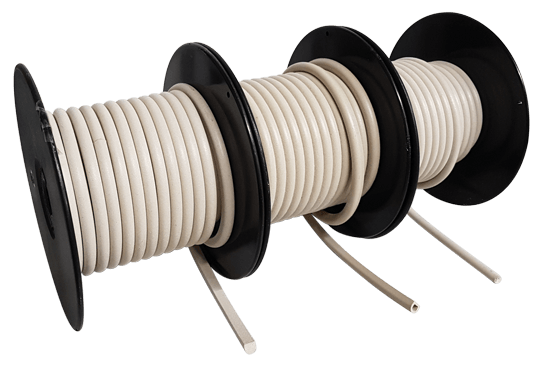
Benefits
- Excellent conductivity throughout the surface
- Excellent electromagnetic shielding effect
- Easy die-cutting, kiss-cutting and slitting
- Temperature range -60 to +185 °C (under certain circumstances, tolerance can be up to 220 °C )
Special material (on request)
These Conductive Rubber Profiles are also available in special materials for special applications, for example applications with chemicals. Below is a list of special materials. For availability and delivery please contact us.
- Silicone Carbon
- Fluorosilicone Nickel Graphite
- Silicone Nickel Graphite Flame Retardant
- Silicone Silver Aluminium
- Fluorosilicone Silver Aluminium
- Fluorosilicone Nickel
- Silver Plated Nickel
- Silver Glass
- Silver copper silicone conductive rubber
Electrically conductive rubber is available as
- Conductive rubber sheets
- Molded parts
- Die-cut, or flash cut
- Strips
Shielding performance
Please note : These values are measured under laboratory conditions. Results may vary in other situations; please read our Guarantee.
Conductive P profile (P)
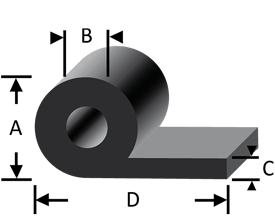
| Part number | A (mm) |
B (mm) |
C (mm) Material thickness |
D (mm) |
|---|---|---|---|---|
| 5760-P-5.0-2.0-1.6-12.7 | 5.0 | 2.0 | 1.6 | 12.7 |
| 5760-P-5.0-2.0-1.6-21.6 | 5.0 | 2.0 | 1.6 | 21.6 |
| 5760-P-6.4-3.2-1.6-12.7 | 6.4 | 3.2 | 1.6 | 12.7 |
| 5760-P-6.4-3.2-1.6-15.9 | 6.4 | 3.2 | 1.6 | 15.9 |
| 5760-P-6.4-3.2-1.6-22.2 | 6.4 | 3.2 | 1.6 | 22.2 |
| 5760-P-7.9-4.8-1.6-22.2 | 7.9 | 4.8 | 1.6 | 22.2 |
| 5760-P-9.1-6.5-1.8-19.8 | 9.1 | 6.5 | 1.8 | 19.8 |
| 5760 can be replaced with 5750/5755 on request | ||||
Conductive hollow D profile (D)
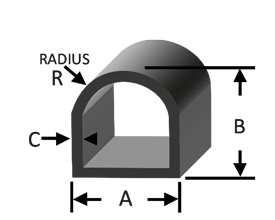
| Part number | A (mm) |
B (mm) |
C (mm) Material thickness |
R (mm) |
|---|---|---|---|---|
| 5760-D-4.0-4.0-1.1-2.0 | 4.0 | 4.0 | 1.1 | 2.0 |
| 5760-D-4.8-4.7-1.3-2.4 | 4.8 | 4.7 | 1.3 | 2.4 |
| 5760-D-6.4-6.4-1.7-3.2 | 6.4 | 6.4 | 1.7 | 3.2 |
| 5760-D-7.9-7.9-1.3-4.0 | 7.9 | 7.9 | 1.3 | 4.0 |
| 5760-D-12.4-8.2-2.0-6.2 | 12.4 | 8.2 | 2.0 | 6.2 |
| 5760 can be replaced with 5750/5755 on request | ||||
Conductive solid D profile: (SD)
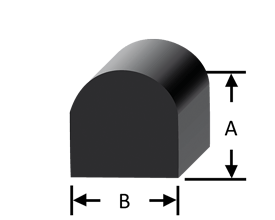
| Part number | A (mm) |
B (mm) |
||
|---|---|---|---|---|
| 5760-SD-1.6-1.4 | 1.6 | 1.4 | ||
| 5760-SD-1.7-1.6 | 1.7 | 1.6 | ||
| 5760-SD-2.0-2.4 | 2.0 | 2.4 | ||
| 5760-SD-2.3-2.0 | 2.3 | 2.0 | ||
| 5760-SD-2.5-1.6 | 2.5 | 1.6 | ||
| 5760-SD-2.8-3.2 | 2.8 | 3.2 | ||
| 5760-SD-3.4-3.1 | 3.4 | 3.1 | ||
| 5760-SD-4.0-3.0 | 4.0 | 3.0 | ||
| 5760-SD-4.0-4.0 | 4.0 | 4.0 | ||
| 5760-SD-4.5-4.5 | 4.5 | 4.5 | ||
| 5760-SD-4.8-4.8 | 4.8 | 4.8 | ||
| 5760 can be replaced with 5750/5755 on request | ||||
U channel profile (U)

| Part number | A (mm) |
B (mm) |
C (mm) |
D (mm) Material thickness |
|---|---|---|---|---|
| 5760-U-2.4-2.5-0.9-0.8 | 2.4 | 2.5 | 0.9 | 0.8 |
| 5760-U-3.2-2.8-0.7-1.3 | 3.2 | 2.8 | 0.7 | 1.3 |
| 5760-U-3.2-5.7-0.5-2.0 | 3.2 | 5.7 | 0.5 | 2.0 |
| 5760-U-4.0-4.0-1.6-1.2 | 4.0 | 4.0 | 1.6 | 1.2 |
| 5760-U-4.5-4.0-1.2-1.9 | 4.5 | 4.0 | 1.2 | 1.9 |
| 5760-U-8.3-6.0-1.6-2.9 | 8.3 | 6.0 | 1.6 | 2.9 |
| 5760 can be replaced with 5750/5755 on request | ||||
DD profile with waterseal (DD)
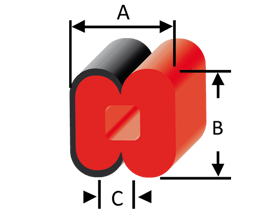
| Part number | A (mm) |
B (mm) |
C (mm) |
|---|---|---|---|
| 5760-DD-4.57-4.75-1.65 | 4.57 | 4.75 | 1.65 |
| 5760 can be replaced with 5750/5755 on request | |||

Benefits
- No reduction of the shielding properties in the splicing area
- Splicing rubber thin and conductive
- No flash, porosity or excess rubber at the joint after splicing
- Max increase of compression force in the splicing area 5%
- No excess splicing rubber inside hollow profiles
- Jointing point should stand for 10% stretch without mechanical damage
- Electrical resistance measure: Max 300 mΩ
- Available in rolls up to 1000 meters
O-profiles
Our conductive rubber o-profiles are listed in a separate product series, the 7900 series. Are you looking for a conductive rubber o-profile, please refer to the Conductive O-profile page.
